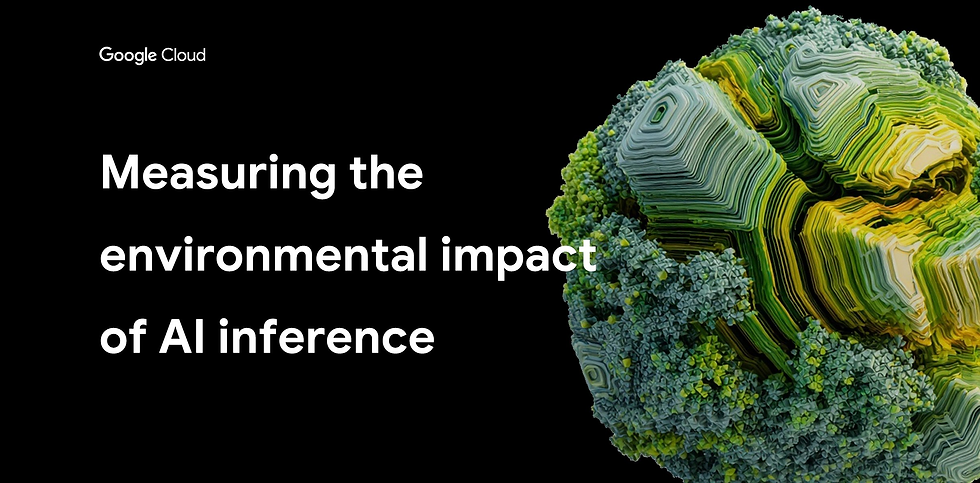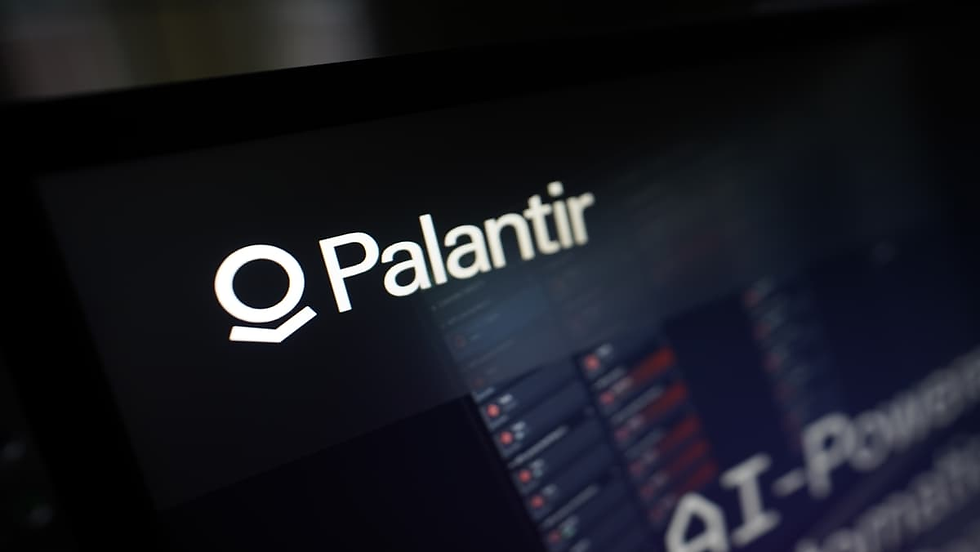Google’s Gemini Energy Report Sparks Debate Over AI’s True Environmental Cost
- Olivia Johnson

- Aug 22
- 11 min read

Google’s new disclosures about Gemini — what reporters call the “Google Gemini energy” and water metrics — have thrust the environmental footprint of generative AI into public view. For the first time a major model provider has published per text prompt energy and water metrics, a step many see as vital progress toward understanding the AI environmental cost of everyday use. But the announcement has also widened a debate: does per‑prompt visibility meaningfully change policy and practice, or does it risk oversimplifying a complex, system‑level problem that includes training, grid interactions, and local water stresses?
This article explains what Google disclosed, why per text prompt energy disclosure matters, and where the gaps remain. You’ll get a clear read on the numbers Google published, how they were measured, the likely electricity and water implications for data centers and grids, academic estimates of AI carbon emissions, technical levers to cut energy per operation, and the policy options and practical steps organizations can take now.
What Google disclosed, at a glance
Google published figures estimating the average energy and water use per text prompt for Gemini when deployed via Google Cloud and Google services. The company framed this as an effort to make model inference — the compute work of answering user prompts — more transparent so customers and regulators can compare the operational footprint of different models and deployment modes. This matters to users who want low‑impact apps, enterprises making procurement decisions, regulators crafting disclosure rules, and grid operators tracking new load patterns.
Why transparency changes the conversation about AI environmental cost
Per‑prompt metrics shift the debate from vague claims to measurable units: a prompt is a natural, repeatable unit that developers and users can relate to. Transparency enables benchmarking and targeted policies, but per‑prompt figures are not a full accounting: they often exclude training energy, manufacturing and lifecycle emissions, and regional grid carbon differences. To move from disclosure to policy we need standardized methods that tie per‑operation metrics into lifecycle frameworks and regional electricity profiles.
Short insight: Per‑prompt disclosure is a breakthrough for operational transparency — but it’s a first step, not a full inventory of the AI environmental impact.
Google Gemini disclosure details, transparency and limitations

Google’s public statements and a Cloud blog post explain the rationale and method behind the new Gemini energy per prompt and Gemini water consumption figures. The company reported estimates of electricity (in joules or kilowatt‑hours per prompt) and water use (liters per prompt) for different model sizes and deployment environments, and described the assumptions used to scale up from server metrics to average user prompts. Google framed this as part of “measuring the environmental impact of AI inference” to help customers make informed choices about latency, cost, and carbon.
The disclosure is notable for three elements: 1. Unitization: expressing energy and water per text prompt creates a usable unit for developers. 2. Scope: metrics focus on inference — the run‑time compute consumed when answering prompts — not the one‑time cost of training. 3. Assumptions: Google published key assumptions (datacenter PUE, typical prompt length, batching behavior) but left some regional and lifecycle variables implicit.
Methodology Google reported for per‑prompt metrics
Inference energy measurements typically start with server telemetry (power draw of GPU/TPU instances during inference), then adjust for:
Power usage effectiveness (PUE) to account for cooling and facility overhead.
Networking and storage overheads depending on request routing and model sharding.
Typical prompt length and tokenization assumptions — longer prompts and responses increase compute.
Batching assumptions — serving requests in batches can significantly reduce per‑prompt energy.
Google’s public method appears to use direct server energy data, scaled by PUE values and amortized across an assumed prompt mix and batching regime. That transparency helps customers compare model sizes and deployment options, and it allows for immediate optimization inside an app (e.g., shorter responses, smarter batching).
Key takeaway: Measuring inference is feasible and useful, but results depend heavily on batching, prompt length and datacenter PUE choices.
What the disclosure does not cover: training and lifecycle emissions
Google’s metrics explicitly exclude training — a technically distinct phase where models are trained on massive datasets and which can produce a concentrated, sometimes dominant portion of a model’s lifecycle emissions. Training a state‑of‑the‑art model involves weeks of high‑power compute, large datasets, and significant cooling loads; even a single training run can equal many years of inference energy for smaller systems. Because of that contrast:
Per‑prompt numbers can understate overall lifecycle emissions if training costs are large and amortized over relatively few in‑production queries.
Manufacturing and embodied emissions of accelerators and servers — and their end‑of‑life disposal — are not included.
Regional grid carbon intensity is crucial: a kWh in one region emits much more CO2 than the same kWh in another.
Short insight:AI inference energy vs training energy is a core distinction — both matter, but they occur at different tempos and must be accounted together for policy.
AI data centers, electricity markets and real world grid impacts

The growth of generative AI has accelerated data center buildouts and shifted electricity demand profiles. Large cloud providers are deploying thousands of specialized accelerators and repurposing existing facilities, increasing both baseload and variable demand. Analysts warn that AI data center energy demand — driven by inference at scale and periodic retraining — will materially affect regional electricity markets, potentially raising prices for consumers and stressing transmission and generation capacity.
Media and industry analyses highlight several market‑level consequences:
Projected demand increases in AI hotspots can outpace local generation and transmission upgrades, leading to capacity constraints and elevated wholesale prices.
Utilities may recover new infrastructure costs through tariffs that could raise consumer electricity costs for households and small businesses.
Rapid data center expansion can conflict with local environmental goals, land use, and water resource management.
U.S. market disruptions from AI data center demand
In the U.S., AI clusters (regions with multiple hyperscale datacenters) have already forced utilities and regulators to rethink capacity planning. New loads can:
Trigger the need for transmission upgrades and peaker plants.
Shift the timing of generation dispatch, particularly for natural gas plants.
Lead to debates about who pays for grid upgrades: taxpayers, ratepayers, or the companies themselves.
Where utilities pass costs to ratepayers through grid tariffs, residential consumers can see higher bills even if companies sign renewable power purchase agreements (PPAs). That disconnection — corporate renewable deals do not always reduce local marginal emissions or relieve transmission constraints — means AI growth can indirectly increase AI environmental impact at the regional scale.
Key action: Regulators should require load‑profile disclosures and cost‑sharing frameworks so local communities do not shoulder disproportionate costs of grid upgrades.
UK data centre expansion, water use and local environmental concerns
The UK has seen disputes over large data center builds, particularly in rural or scenic areas. Concerns include:
Data centre water consumption for evaporative cooling and closed‑loop systems that stress local supplies during droughts.
Land use impacts: large footprints and associated infrastructure (substations, fiber routes) fragment landscapes and affect local ecosystems.
Local employment benefits versus environmental costs, often leading to polarized planning debates.
Community pressure has led some local authorities to tighten planning rules and consider water‑use limits or offset requirements. These local measures can be powerful policy levers when combined with sectorwide transparency.
Quantifying AI energy use and carbon, academic estimates and frameworks

Estimating the total climate impact of AI is challenging but critical. Recent academic work models a range of scenarios for AI adoption and its economy‑wide energy and CO2 implications. Estimates vary widely because they depend on assumptions about model efficiency improvements, the pace of adoption, the carbon intensity of marginal electricity, and the distribution between on‑device, edge, and cloud compute.
One recent preprint projects substantial increases in electricity demand and CO2 under high‑adoption scenarios — a reminder that AI carbon emissions are not hypothetical. Another paper lays out practical frameworks for software carbon intensity measurement so organizations can convert instance telemetry into comparable carbon estimates.
Macro estimates of AI’s economy‑wide energy and emissions impacts
Studies model AI’s aggregate impact by combining:
Per‑operation energy estimates (inference + retraining),
Adoption trajectories across industries,
Grid decarbonization rates and marginal emission factors.
Findings typically show a wide variance:
Low‑adoption / rapid decarbonization scenarios result in modest net increases or even neutral outcomes.
High‑adoption / slow grid decarbonization scenarios can produce multi‑percent increases in national electricity demand and notable CO2 upticks.
Key sensitivities in these models include:
Whether cloud providers shift workloads to low‑carbon regions or operate carbon‑aware scheduling.
Efficiency improvements in hardware and software (e.g., quantization, distillation).
Policy responses such as demand management, tariffs or mandatory disclosure.
Insight: Uncertainty is large, but the direction is clear — without targeted interventions, widescale AI adoption could raise industry-level energy increase significantly.
Practical measurement frameworks for practitioners and cloud users
Two practical concepts help translate telemetry into policy‑useful metrics:
Software Carbon Intensity (SCI): the grams CO2e per unit of computing work (e.g., per request or per 1,000 tokens). SCI combines energy consumption of an instance, the instance’s utilization pattern, and the location‑specific grid carbon intensity at the time of execution.
Cloud instance measurement: gather per‑instance power telemetry, apply PUE and network overheads, then multiply by regional marginal CO2 per kWh.
Steps for companies: 1. Instrument applications to record request counts, token counts, and average latency/batching. 2. Capture cloud instance types, utilization rates and regional deployment details. 3. Apply an SCI framework (or tools that implement it) to estimate grams CO2e per prompt. 4. Report trends and set reduction targets (e.g., grams CO2e per 1,000 prompts).
Actionable step: Adopt SCI as a standard KPI for AI services and require cloud providers to expose per‑instance energy telemetry and regional carbon factors.
Training large models, inference scaling and technical energy challenges

Training remains a major driver of AI’s carbon footprint. Cutting‑edge models are trained on vast datasets using thousands of accelerator‑hours; those runs can require as much energy as many years of inference for smaller systems. But as inference scales — as millions of users generate prompts daily — the cumulative energy of inference can exceed training footprints over time. Both phases require targeted mitigation.
Training cost dynamics and research on large model footprints
Research demonstrates scaling laws: as model size and dataset scale increase, energy use and carbon footprints grow nonlinearly. A few key points:
Training energy scales superlinearly with model size unless architecture changes or training algorithms reduce iterations.
Retraining and continual learning (updating models frequently) multiply these costs.
Model reuse and transfer learning can reduce the number of full‑scale trainings, but fine‑tuning still consumes meaningful energy.
Because training footprints are concentrated, transparency about them (energy, emissions per training run, and amortization assumptions) should complement per‑prompt disclosures. Without that, per‑prompt figures risk understating the full lifecycle impact of deploying large foundation models.
Practical insight: Require model providers to publish training run energy and emissions alongside per‑prompt metrics and the assumed amortization factor (how many prompts are counted against each training run).
Infrastructure and software optimizations to lower per‑prompt energy
There are many technical levers to reduce energy per inference:
Model‑level: distillation (smaller model approximations), quantization (lower‑precision arithmetic), sparsity techniques reduce FLOPs per inference.
Serving‑level: server‑side request batching, model caching, and prompt truncation lower average energy per prompt.
Hardware: newer accelerators are more energy efficient per FLOP; matching model architectures to accelerator strengths improves PUE.
Operations: region‑aware routing (sending requests to low‑carbon regions), carbon‑aware load scheduling (scheduling non‑urgent work when renewables are abundant), and improving facility PUE through better cooling and heat reuse.
Example mitigations and expected effects:
Batching can reduce per‑prompt energy by 20–60% depending on workload.
Quantization and distillation can reduce model size and inference energy by 2–10× in practice, with some loss in quality that must be managed.
Recommendation: Enterprises should prioritize model optimization (distillation/quantization) and server‑side batching in production deployments — these measures are high‑impact, low‑friction ways to reduce AI energy use.
Policy, industry responses, solutions, FAQ and conclusion with actionable insights

Google’s disclosure comes at a time when policymakers and industry groups are debating regulatory approaches to AI’s environmental footprint. Proposed legislative responses — from federal disclosure mandates to state‑level water and planning rules — are gaining traction. Industry responses have included corporate transparency initiatives, renewable energy procurement, and efficiency roadmaps. But aligning incentives, ensuring comparable disclosures, and protecting consumers and local environments remain open policy challenges.
Policy and regulatory levers to address AI environmental cost
Policymakers have multiple tools:
Disclosure mandates: require model providers to publish standardized per‑operation energy and water metrics and training run footprints.
Planning and water rules: state and local authorities can condition data center permits on water use limits, reuse plans, or offsets (examples are emerging in states that host large data center clusters).
Grid instruments: dynamic tariffs, capacity cost allocations, or demand charges to reflect true marginal system costs of new loads.
Market instruments: incentivize carbon‑aware scheduling with differentiated prices or procurement rules that credit low‑carbon execution.
Policy action: Standardize per‑operation reporting (unit, methodology, and assumptions) across major providers, and require disclosure of training energy and amortization practices.
Industry best practices and technological mitigation strategies
Companies and cloud providers can adopt a short list of high‑impact strategies:
Publish per‑prompt energy and water metrics with clear assumptions, and disclose training run footprints.
Set targets for software carbon intensity reductions per unit of service.
Use demand‑side management: batch non‑real‑time tasks, schedule retraining during low‑carbon hours, and route inference to regions with lower marginal emissions.
Invest in hardware efficiency and server PUE improvements; adopt closed‑loop cooling and explore water reuse to mitigate data centre water consumption.
Pair PPAs with localized measures that reduce marginal emissions and transmission constraints, such as energy storage or grid upgrades funded by provider investments.
Industry guidance: Combine transparency with operational changes — disclosure without action can mislead stakeholders, while action without disclosure leaves stakeholders unable to verify progress.
FAQ — Five to eight common questions about Gemini, AI energy and carbon
Q1: What does Google’s per‑prompt energy disclosure actually measure and not measure? A1: It measures estimated electricity and water for inference per prompt, using server telemetry plus facility assumptions (PUE, batching). It does not measure training energy, embodied hardware emissions, or lifecycle manufacturing impacts unless explicitly stated.
Q2: Does per‑prompt disclosure mean Gemini is low‑carbon by default? A2: No. Per‑prompt numbers are one dimension. The carbon outcome depends on where and when inference runs (grid carbon intensity), how training is amortized, and how much total usage scales.
Q3: How much of AI’s footprint is training versus inference? A3: It varies. For massive foundation models, training can be a large upfront share; but as inference scales to millions of users, cumulative inference can exceed a single training run’s footprint. Both must be reported for full lifecycle accounting.
Q4: Can users reduce their prompts’ environmental impact? A4: Yes. Shorten prompts and responses, use smaller models or distilled versions, prefer batch requests when possible, and choose services that publish location and carbon metrics.
Q5: What regulatory changes are likely in the near term? A5: Expect increased disclosure mandates, local water‑use conditions for data center permits, and experiments with grid tariffs that reflect large new industrial loads. Some jurisdictions may require training footprint reporting or amortization disclosure.
Q6: How can companies measure software carbon intensity for AI in the cloud? A6: Implement telemetry for request counts and instance utilization, collect per‑instance power data from the provider, apply PUE and network overhead factors, and multiply by regional marginal CO2 per kWh. Use SCI as a KPI.
Q7: Will data center expansion inevitably raise consumer electricity bills? A7: Not inevitably, but poorly managed expansion can. If grid upgrades and capacity costs are socialized through rates, households may see higher bills. Fair cost allocation and direct investments from providers can mitigate this.
Q8: What immediate steps should policymakers take to balance AI growth and environmental protection? A8: Mandate standardized per‑operation disclosures, require training footprint reporting, integrate data center planning with regional water and transmission planning, and incentivize carbon‑aware scheduling and storage deployment.
Conclusion: Trends, opportunities and concrete next steps

Google’s Gemini energy and water disclosures are a consequential and welcome step toward operational transparency in AI. By publishing per text prompt energy disclosure, Google has created a practical unit that developers, enterprises, and regulators can use to benchmark and optimize. That said, the disclosure is intentionally scoped to inference; a complete account of AI environmental cost requires training footprints, lifecycle emissions, and regional grid context.
Bold takeaways:
Transparency works: per‑prompt metrics make operational footprints visible and actionable.
Don’t confuse visibility with completeness: inference metrics must be paired with training and lifecycle reporting.
System effects matter: AI data center growth affects electricity markets, local water resources, and land use; policy must manage these system impacts.
Tools exist: Software Carbon Intensity and cloud instance measurement frameworks can standardize reporting.
High‑impact interventions are feasible: distillation, quantization, batching, region‑aware routing and carbon‑aware scheduling offer near‑term reductions, while policy can steer grid investments and fair cost allocation.
Concrete next steps for stakeholders:
For model providers: Publish both per‑prompt and per‑training‑run energy and water footprints, with clear amortization assumptions. Openly expose per‑instance telemetry and regional execution logs for third‑party verification.
For cloud customers and enterprises: Adopt SCI as a KPI, instrument usage telemetry, choose optimized model variants, and implement batching and routing policies that minimize carbon intensity.
For policymakers: Mandate standardized reporting units and methods, align planning for data centers with transmission and water utility planning, and consider tariffs or market instruments that reflect marginal system costs.
For researchers and NGOs: Continue refining lifecycle accounting methods and provide independent audits and benchmarks to avoid greenwashing.


